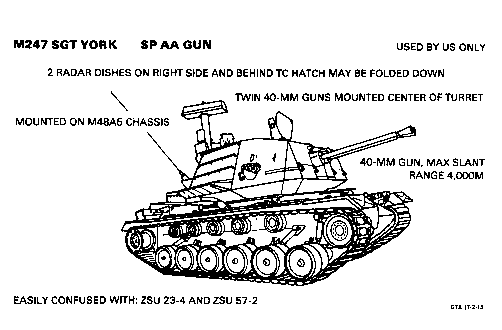M247 Sergeant York DIVAD (original) (raw)
Over a period of three decades four successive generations of upgraded forward area air defense systems -- from Mauler to Roland to Sgt. York to ADATS -- were all canceled, at a total cost of more than $6.7 billion.
The M247 Sergeant York DIVAD (Division Air Defence gun) was born of the Army's need for a replacement for the ageing M163 20mm Vulcan A/A gun and M48 Chaparral missile systems. With the Soviet Mi-24 Hind attack helicopter being fitted with the longer range AT-6 SPIRAL Anti-tank missiles and twin barrelled 23mm cannon, and the Mi-28 Havoc nearing deployment, the M163 and M48 systems would be out-classed in a future conflict. In addition, the Soviet's ZSU-23/4 SHILKA Quad 23mm A/A gun combined a radar with a proven gun fitted to an existing chassis resulting in a highly successful and lethal design.
The new self-propelled anti-aircraft gun system was to be based on the M48A5 tank chassis, using as much off-the-shelf equipment as possible. Two designs were submitted, one from General Dynamics using twin 35mm Oerlikon cannon (as with the West German Leopard) and the other from Ford Aerospace and Communications Corporation which utilised twin 40mm L/70 Bofors Guns. In May 1981 the Ford Aerospace entry was selected and designated M247 Sergeant York, featuring the twin 40mm guns mounted in a new box like armoured turret with both tracking and surveillance radar fitted atop, these could be folded down to reduce overall height. The gunner was provided with roof mounted sight incorporating a laser range-finder. the commander having a panoramic roof mounted periscope and fixed periscopes. The radar was a modified version of the Westinghouse APG-66 system used in the F-16 Fighting Falcon. With the first production vehicles being delivered in late 1983 many problems remained, the most serious being the radar's inability to track low flying targets due to excessive ground clutter. The radar could not distinguish between a hovering helicopter and a clump of trees. And when tracking high flying targets, the radar return from the gun barrel tips confused the fire control system. Turret traverse was also too slow to track a fast crossing target. The ECM (electronic counter-measures) suite could be defeated by only minor jamming. And the use of the 30 year old M48 chassis design meant the vehicle had trouble keeping pace with the newer M1 Abrams and M2/3 Bradley's, the very vehicles it was designed to protect. These problems proved insurmountable, and in December 1986 after about 50 vehicles had been produced the entire program was terminated.

